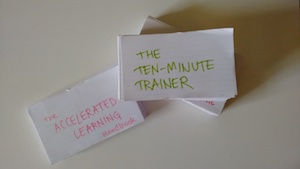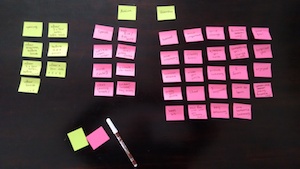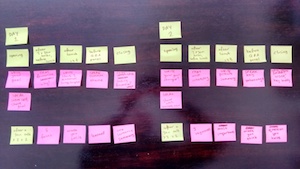The other day, Igy asked if I would MC the Cape Town UX South Africa conference again this year. I said yes and immediately started thinking about how I might go about doing a good job of it. Here’s how I’ve approached it so far.
I want to take a similar approach to last year. I’ll treat it like organising a workshop and see what I can do to help attendees get more out it. For me, that means helping them be a bit more connected, active, and reflective. Whenever I prepare for a workshop, I tend to do these kind of steps:
- look at how I did it last time (to see what I learned and how I can improve);
- dip back into some first principles stuff (like frameworks and guidelines and notes, to remember some tools and techniques);
- bring it together (the first draft of the thing);
- leave it for a few days (to let it percolate);
- iterate (come back to it with fresh ideas and perspective).
Preparation
I started by looking at what I wrote about the experience last year. Then I grabbed three packs of flash cards that I’ve made for myself. They’re notes from three excellent books: Training From The Back Of The Room; The Ten-Minute Trainer; The Accelerated Learning Handbook. Something that jumped out at me from going through the cards was the importance of variation.
I made a list of the slots that I’d have a chance to do something in: opening and closing, between talks, and so on. I made a list of actions that people could do: speaking, writing, voting. I made a big list of mini-prompts for activities: what did you learn, what’s a one sentence summary, things like that.
I tried fiddling with that for a bit, but I couldn’t quite see a way to start pulling it together. It felt like I had too many options and I couldn’t figure out what might go where. So, I took a break. I went off and did some other stuff for a while to clear my head, and came back to it later.
Pulling it together
When I looked at the spread of stickies after a break, I realised that certain types of activities where better suited to certain slots.
- Writing-based activities weren’t going to be good for just before a break: people want to grab food and drink.
- Activities that had a summary kind of theme would be great for just before the speaker Q&A panel. They could help dig up thoughts about all the talks during the day and prompt some new questions.
- Open-ended speaking-based activities would be good for just before lunch. It could be a useful to nudge conversations towards to the topics of the talks.
With these, and a few other ideas, in mind I decided to approach it a bit like a timetable. I mapped out the day and pulled in an activity for each slot. I tried to bear in mind the type of activity that would be a good fit. For the between-talk slots I focused on making them all quite different from each other, and from the other activities.
Now I’m going to leave this for a few days and come back to it with a fresh set of eyes.
Plus a workshop
I may be overthinking this MC thing. But I’d much rather spend some time thinking about it and do an okay job than not think about it and do a terrible job. Perhaps more importantly: there will definitely be some crisp high fives. :)
On top of the MCing, I’m running an accessibility-themed workshop with Nicola du Toit on the third day of the conference. Yay! I’m trying to bring accessibility more to the forefront of the work I do this year. Giving talks and running workshops is one of the ways I’m trying to do so.


